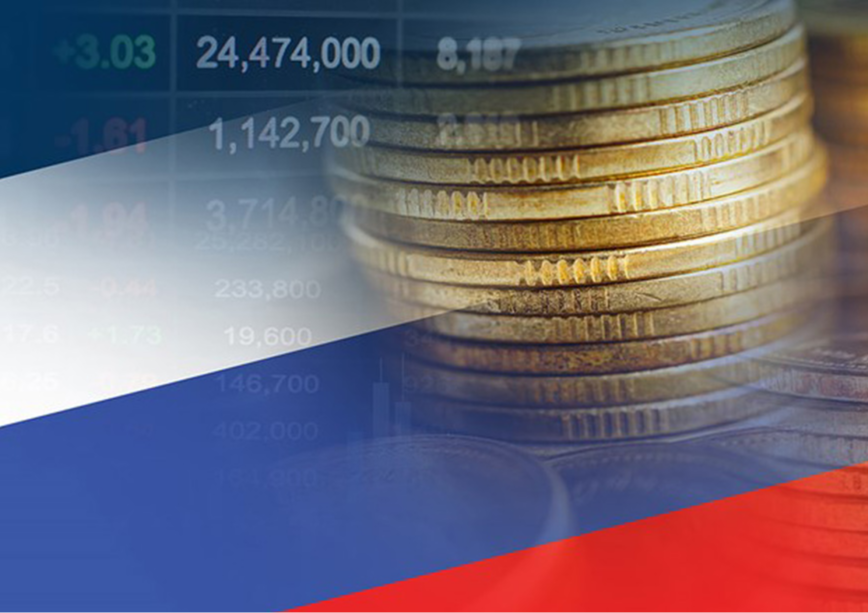
In the aftermath of the initial weeks of the Russian invasion of Ukraine, Russia became the world’s most sanctioned economy. Despite expectations of an economic collapse, following the pandemic as the economy initially faltered with a GDP growth rate of -4.5 percent, by the end of 2022, Russia began to recover, reaching a modest -1.2 percent GDP growth and entered 2023 with solid growth rates, peaking at 3.6 percent. Additionally, real wages in Russia surged by 9.4 percent compared to July 2022. Which prompts the question: How did Russia maintain positive growth throughout 2023 despite enduring comprehensive Western sanctions and the financial strain of the Ukraine conflict?
The Russian economy since 2022: War economy
Russia’s economy is heavily centralised, with most state ownership in the energy, banking, defence, and transportation sectors. A significant amount of revenue is generated from the export of energy and defence. The immediate impacts of the sanctions on the economy saw inflation increase in Russia to 17.9 percent in Q2 of 2022. Russian imports were impacted due to sanctions on the Russian banking system, including its US$300 billion out of the US$600 billion Russia has in its foreign exchange reserves, which severed its access to the international financial system.
The war in Ukraine has created an increasing demand for the military-industrial complex, creating employment in the military factories and the reconstruction of the newly occupied territories in Ukraine.
Policymakers have been preparing for a re-configuration of the economy since 2014, where the sectors were divided into rent-generating and rent-dependent sectors. The former, which includes Russia’s profitable energy, agriculture, and defence sectors, would infuse capital into the rent-dependent sectors, such as the automobile, oil and gas parts, shipbuilding, and state sector employees. This re-configuration circulated the economy and built a form of resilience. The war in Ukraine has created an increasing demand for the military-industrial complex, creating employment in the military factories and the reconstruction of the newly occupied territories in Ukraine. Regions such as Nizhny Novgorod, Sverdlovsk, Tula, Samara, and Novosibirsk saw a high demand for labour due to the concentration of defence factories. Wages in these factories are higher than civilian ones, creating a de-commodified labour force in Russia that is flocking to the more profitable defence industry. The sudden migration to the defence sector and Russians leaving the country has resulted in significant job losses in the civilian sector; in 2023, Russia had a shortage of 4.8 million workers. All this indicates economic growth that is spurred by military spending or military Keynesianism.
Fiscal reforms
Russia’s Central Bank’s role in stabilising the ruble against external shocks has been crucial. Elvira Nabiullina, the Governor of the Bank of Russia, was earlier awarded the Central Banker of the Year 2015 and 2017 for being able to build economic resilience against external shocks, and control the inflation rate in Russia, and undertake banking sector reforms. After the Ukraine war broke out, Russia’s Central Bank imposed capital control laws. The Bank of Russia raised the interest rate from 9.5 percent to 20 percent, which arrested capital flight and helped stabilise the ruble. Further, the Russian firms were barred from transferring foreign money overseas and faced a six-month cap on amounts withdrawn from Russian banks. The Russian firms receiving payments in foreign currencies had to convert 80 percent (later abolished) of those earnings into rubles, which is why we observe that in the first year of the invasion, the Russian economy was able to absorb the shocks. However, by mid-2023, the ruble began to devalue, mainly due to Russia’s trade surplus shrinking because of increasing imports. The central bank raised the interest rate to arrest the devaluing ruble and aggressively targeted inflation. Elvira Nabiullina has expressed concern and warned that the sanctions against Russia may intensify as the economy runs the risk of overheating. Further, the legal minimum wage was raised to US$212.60 (20,000 rubles), and pensions were hiked by 10 percent a month before the Ukraine conflict.
The Russian firms receiving payments in foreign currencies had to convert 80 percent (later abolished) of those earnings into rubles, which is why we observe that in the first year of the invasion, the Russian economy was able to absorb the shocks.
Import Substitution Policies
Scaling up domestic manufacturing in Russia has been on the minds of policymakers since 2014; the government commission for import substitution was formed in 2015, with 2,000 projects across 20 branches, a budget of over 1.5 trillion rubles, and a roadmap till 2030. Since 2014, the emphasis has been placed on non-sanctioned industries such as pharma, IT, and civil aviation (before 2022). For instance, Russian aviation companies have placed orders for the domestically manufactured MC-21 and Sukhoi Superjet-100 since Airbus and Boeing’s planes have placed import restrictions on Russia. According to the National Research University of Higher School of Economics in Moscow, Russia’s industry complex currently depends on imports by less than 40 percent. The dependence rate on imports varies from sector to sector. The dependence on imports is high for machinery, pharmaceuticals, fertilisers, electrical machinery, and medical instruments; as the work is underway, Russia is facing difficulties in some sectors of the economy, such as mining and manufacturing. The import substitution policy has created employment and generated economic growth in some Russian regions.
Impact of sanctions and sanctions circumvention
Unlike the sanctions imposed in 2014 in response to the illegal annexation of Crimea, the sanctions imposed in 2022 were an all-out sanctions campaign, similar to one imposed on Iran on paper. However, reality contrasts the intent behind the sanctions. Russia’s natural gas and oil are heavily linked with markets in Europe. Even when the US imposed sanctions on Russian energy in 2015, the European Union (EU) did not sanction Russia’s natural gas giant, Gazprom, or Rosneft (Russia’s largest oil company). The EU continued to buy Russian energy because several central European, Baltic, and Eastern European nations are integral to the functioning of Russian energy value chains. For instance, Hungary’s MOL Group and Unipetrol in the Czech Republic are among several European companies that refine Russian oil and are exempted from sanctions. Russian energy giants have a stake in companies across Europe that are involved in the midstream and downstream processes. This form of dependence makes it very difficult for nations to cut energy relations with Russia. Further, year-on-year Russian exports have increased; for instance, in 2022, Russian exports stood at US$591 billion, 20 percent more than in 2021.
The EU continued to buy Russian energy because several central European, Baltic, and Eastern European nations are integral to the functioning of Russian energy value chains.
Another reason the Russian economy has grown is because of laundromat countries, which purchase Russian oil and sell unprocessed/processed products to European countries. India, the United Arab Emirates (UAE), Türkiye, China, and Singapore lead the group and do not purchase oil at the price cap set by the G7. This means that Western sanctions on Russia have not had a debilitating impact on Russia.
Parallel import systems
The Ministry of Industry and Trade published a list of goods for parallel imports, which included automobile parts, parts dedicated to rail transport, aviation spare parts, electronics, cosmetics, and even luxury goods. Parallel imports refer to goods imported into a market without the manufacturer’s consent. Many unauthorised imports from Kazakhstan, Armenia, and Belarus enter Russia. From May 2022 to November 2022, parallel imports to Russia reached US$17 billion. In 2023, Moscow imported US$1.7 billion of advanced semiconductor chips, which are being used in their drones in the Ukraine war. Even highly regulated dual-use goods have found their way into Russia.
Conclusion
Ever since the war in Ukraine, the Russian economy built adaptive resilience against sanctions; the technocrats worked round the clock to ensure the ruble’s stability. Despite the onset of devaluation since mid-2023, the social security measures have been satisfactory for the Russians to build a degree of resilience from the sanctions; one can go as far as to state that even the recent list of 500 sanctions imposed by the US President Joe Biden after Navalny’s death may not impact the Russian economy as intended. Considering these parameters, Russia has done reasonably well and paved the way for a more than possible fifth term for President Putin in the upcoming presidential elections in March. However, the rising military spending, which is spurring economic growth, is a concern for the long term, as over-reliance on military spending can lead to economic stagnation even if the war in Ukraine were to end.
Rajoli Siddharth is an intern with the Strategic Studies Programme at the Observer Research Foundation
The views expressed above belong to the author(s). ORF research and analyses now available on Telegram! Click here to access our curated content — blogs, longforms and interviews.




 PREV
PREV


